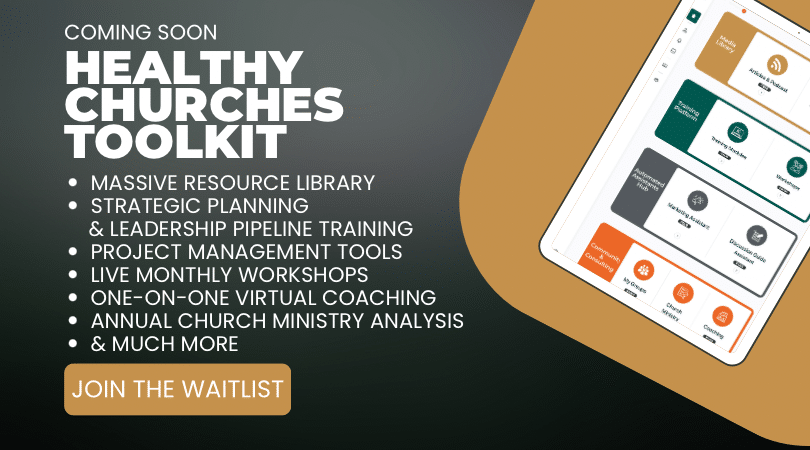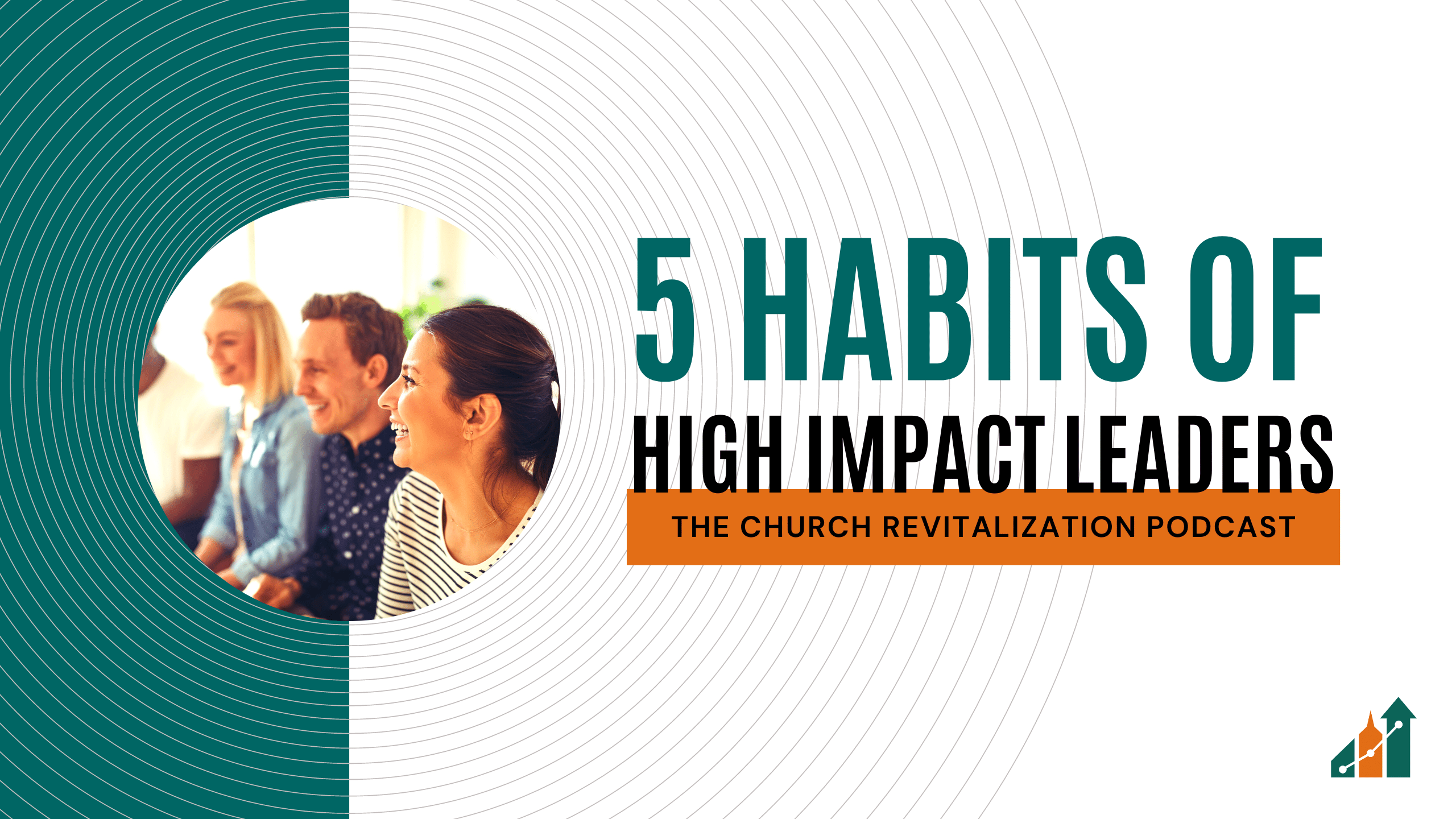The Church Revitalization Podcast – Episode 121
5 Habits to help you become a High Impact Leader
Habits get a bad rap, but there are good habits to be had, and that’s what we’re talking about today…
One of the things I’ve always found fascinating about physicians is their use of the term “practicing medicine.” When you’re doubled-over in pain, and you rush to the hospital, the first thought in your mind probably isn’t, “I want a doctor who is just practicing to figure out what’s wrong with me!” You’d likely prefer the thought of a practiced physician–someone who mastered medicine.
But the truth is that there’s no such thing as mastering medicine. Our understanding of biology, pharmacology, and physiology is ever-deepening. The only way to approach becoming a master physician is to stay humble and keep practicing medicine.
Likewise, becoming a high-impact leader in the church isn’t an achievement you can earn at a moment in time and set on the shelf like a trophy. Mastering leadership requires practicing leadership. And practicing leadership well requires leveraging certain habits.
Spend a few moments reflecting on your leadership. Think of the people who are impacted by your sphere of influence. Are they thriving? Can you see them accomplishing their dreams and their goals? Are you working together in harmony towards a greater purpose? Are there any gaps in your character, or in the character of those you lead?
I know for me, as I look at that litany of questions, I have a long way to go in my leadership. I’m not the leader I desire to be, that God is calling me to be, and that the people I lead need me to be. All the more reason for us to keep practicing!
Here are five habits that high-impact leaders use to help them perfect their practice of leadership.
Subscribe below to never miss an episode.
Embody the Values
Having a title is not enough to earn genuine respect. Being married doesn’t make you a good spouse, and having kids doesn’t make you a good parent. You have to embody the values you want to see reflected in your home in order to engender that respect. The same is true in your church.
Want to see more people committed to reading Scripture? How much time are you investing in the Word? If you want to see your folks invested in community, are you willing to be vulnerable and engage with a small group? Are you an example of what it means to share your faith with others outside the four walls of the church?
A high impact leader understands that they cannot expect others to live out values that they themselves are unwilling to emulate. None of us is perfect, and we can have seasons (even long ones) where we fall short of living out the values we espouse. But focus on developing the habit of embodying the values you want to see in your church, and don’t be surprised when the culture around you begins to shift for the better.
Enlist Others in Vision-Building
A characteristic of high impact leadership is the ability to influence others through an inspiring vision. A great leader sees the potential of the future and motivates others to move towards that vision. But the best leaders understand that the most successful path to achieving vision isn’t generating buy-in, it’s building ownership.
People are far more likely to work towards a vision if they had a hand in shaping it. While the key leader is often the chief architect of a vision, there are a vast number of details that ought to be owned by others in the organization.
My family loves going to Disney. One of my favorite past times on Disney trips is looking for “Hidden Mickeys” around the parks, resorts, and attractions. On a recent trip, a family friend showed us one of the most obscure Hidden Mickeys at Disney. Just outside the Enchanted Tiki Room, embedded in the concrete, is a pair of Mickey-shaped earrings. Unless you’re looking very closely, you would never see it as you were walking. But some inspired cast member, who caught the vision for inspiring magic, made a fun and delightful hidden surprise. No chief executive in Anaheim told that employee to make that choice. He or she did it because they understood the vision and values, and they owned it.
Likewise, a high impact leader habitually enlists others in vision-building. As a result, the people around them transform a solitary vision into something even more beautiful, rich, multi-faceted, and inspiring. A great leader’s vision may be inspiring. But a high-impact leader’s vision, with the help of those around him, is transformational.
Experiment and Take Risks
The status quo is a myth. There is no scenario where everything in your church stays the same two years from now as it is today. Change is coming for you and your organization, regardless of your attitude toward change. One of the things I often say to church leaders is that they can either have a voice in change or be a victim of it.
Therefore, high impact leaders have a habit of experimenting and taking risks. To shape the change that happens in your church, you need to be willing to try things you aren’t sure will work. Several years ago, I heard Larry Osborne speak at a conference. He said that churches have a bad habit of fully committing to every change they try; instead, churches should beta test lots of things. This is so true. How many times have you wanted to try a new ministry or program, so you invested tons of time and resources into promoting it and fitting it into your permanent infrastructure? Then, if it doesn’t work out, people roll their eyes and are less enthusiastic about trying another new idea.
Instead, look at most new changes as a beta test. Find ways to try new ideas in a smaller, lower-risk environment. Then scale it up if it works. Only after testing, invest in promoting and promulgating it across the whole church.
Seek out ways to innovate and improve. Take risks. The gates of hell will not prevail against a church that’s on the move. But the gates of hell have no fear of a church that fails to move. Therefore, build a habit of innovation, experimentation, and risk-taking.
Empower Your Team
Look at the ministry around you. Does everything depend on you to happen? If the answer to that question is affirmative, you have a serious leadership challenge. High impact leaders have a habit of empowering others to make decisions, shape change, take risks, and accomplish their goals.
Developing the empowerment habit hinges on a few, key prerequisites. First, you need a team to empower! If everything depends on you because you don’t have a team at all, then your first step is to recruit qualified people to serve alongside you. Even if you’re in a small church and you’re the only paid staff member, you can surround yourself with lay leaders that are qualified to lead with you.
Second, empowerment requires trust. If you don’t believe that the people around you are capable of making good decisions, you will likely disempower them intentionally or unintentionally. If you do not trust your team, ask yourself why? Is it because they aren’t trained enough or are not qualified enough? Do you not trust them because of your own insecurities? Build a trusting relationship with your team so that you can empower them to act.
Finally, the empowerment habit hinges on maximizing the skill set of your team. People can only act up to their ability. Focus on developing your team; coach them so that they reach their full potential. An underdeveloped team is a terrible thing to waste.
The high impact leader has a habit of empowering the people around them to own the shared direction, make decisions, and act.
Celebrate Others
Good leadership isn’t just about the nuts and bolts of getting things done. At the end of the day, high impact leadership is mostly about relationships. Achieving great things is difficult and tiresome work. You’ll have more than your fair share of losses along the way. Therefore, high-impact leaders have a habit of encouragement. They understand that a team is only as effective as the quality of their morale.
Sometimes church leadership feels more like the infamous quip, “The beatings will continue until the morale improves.” But the best leaders understand that taking time to encourage the souls of people is time well spent. Find little victories to celebrate, and share the success with others. Don’t be so hungry for the next win that you fail to acknowledge the hard work of the team.
When things go poorly, find the silver lining that the team can rally around–even if that silver lining is our hope in an all-powerful Savior. Remember that church leadership is spiritual leadership first and strategic leadership second. While the spiritual and strategic work hand-in-hand, the Savior calls us to be shepherds who feed the sheep. This includes your team.
Build the habit of encouraging others, celebrating them, and inspiring them to take the next challenge with confidence.
Becoming a great leader requires practicing leadership. We are all on a journey, and our leadership skills will mature and evolve over time. Leaning into these five leadership habits can accelerate your development towards becoming a high impact leader.
Author’s note: The list of habits in this article was inspired by The Leadership Challenge by Kouzes & Posner (Chapter 1).
BONUS: Get a free Team Discussion Guide in the video description on YouTube.


Scott Ball is the Vice President and a Lead Guide with The Malphurs Group. He lives in East Tennessee with his wife and two children. (Email Scott).

